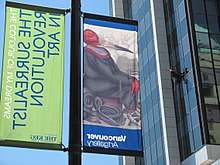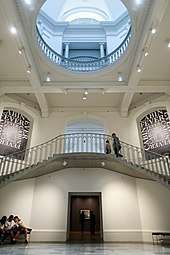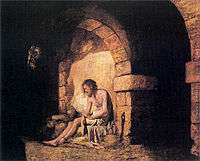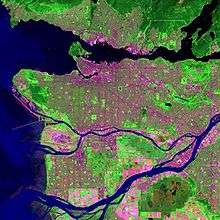Vancouver Art Gallery
The Vancouver Art Gallery (VAG) is an art museum located in Vancouver, British Columbia, Canada. Situated in downtown Vancouver, the museum occupies a 15,300-square-metre-building (165,000 sq ft) adjacent to Robson Square, making it the largest art museum in Western Canada by building size. Designed by Francis Rattenbury, the building the museum presently occupies was originally opened as a provincial courthouse, before it was re-purposed for museum use in the early 1980s. The building was designated as the Former Vancouver Law Courts National Historic Site of Canada in 1980.
 | |
.jpg) Northeast facade of the Vancouver Art Gallery | |

| |
| Established | April 1931[1] |
|---|---|
| Location | 750 Hornby Street, Vancouver, British Columbia, Canada |
| Coordinates | 49.282875°N 123.120464°W |
| Type | Art museum |
| Director | Daina Augaitis[note 1][2] |
| Curator | Diana Freundl (Chief Curator)[note 1][2] |
| Website | vanartgallery.bc.ca |
The museum was opened to the public in 1931 in a building designed by architectural firm Sharp and Johnston. The museum expanded its first building once in 1950, before plans were undertaken to move the institution to the former provincial courthouse building. The museum was relocated to the provincial courthouse in 1983. Plans were undertaken by the museum in the late 2000s and 2010s to relocate the institution to a new facility in Larwill Park.
The Vancouver Art Gallery's permanent collection serves as a repository of art for the Lower Mainland region, and has approximately 12,000 works by artists from Canada, and around the world. In addition to exhibiting works from its collection, the museum has also organized, and hosted a number of travelling arts exhibitions.
History
In April 1931, the Vancouver Art Gallery Association was established under the provincial Society Act, in order to establish and maintain a museum for the City of Vancouver.[1] The Association opened the art museum to the public at 1145 West Georgia Street on 5 October 1931.[3] The building was designed by architectural firm Sharp and Johnston, and featured four galleries, one of which included a sculpture hall, a lecture hall, and a library.[4] The cost to construct the building was approximately C$40,000.[4]

Works by British, and other European artists dominated the works exhibited at the museum at the time of its opening.[4] In 1938, the museum was the one of the buildings occupied by unemployed protesters during a sitdown strike in the weeks leading up to Bloody Sunday.[5] No paintings were damaged while the protesters occupied the building.[6]
In 1950, the museum conducted renovations to its building, reshaping the design of the building towards an International Style of architecture;[6] with the removal of the building's Art Deco facade.[7] Renovations were also conducted to accommodate the 157 works bequeathed to the museum by Emily Carr, with the building reopened to the public in 1951.[7] Cost for the renovation was approximately C$600,000, funded by the City of Vancouver government, and funds raised by Lawren Harris.[8]
In 1983 the museum was relocated to its present location, the former provincial courthouse.[6] The building continues to be owned by the Government of British Columbia, although the museum occupies the building through a 99-year sublease signed with the City of Vancouver government in 1974;[8] who in turn leases the building from the provincial government.[9] Before the re-purposed building was opened to the public, it was renovated by architect Arthur Erickson at a cost of C$20 million, as a part of his larger three city-block Robson Square redevelopment.[7] The gallery connects to the rest of Robson Square via an underground passage below Robson Street.
.jpeg)
Plans to build a new building for the museum were undertaken in 2004, a result from its need for more exhibition and storage space for its collections.[7] In November 2007, the museum publicly announced plans to move to seek approval from Vancouver City Council to build a new building at Larwill Park, a block formerly occupied by a bus depot on the corner of Cambie and Georgia streets.[8] However, in May 2008, the museum and the City of Vancouver government announced its intention to relocate to an area occupied by the Plaza of Nations.[10] The Vancouver City Council later reversed its decision in April 2013, opting to approve the original proposed site in Larwill Park.[11] In September 2013, the museum formally issued requests for qualifications to construct the new building, receiving responses from 75 architectural firms from 16 countries.[12] In April 2014, Herzog & de Meuron's bid was selected by the museum.[12] The development of the Vancouver Art Gallery's new building is the first project for the architectural firm in the country.[12] Perkins and Will's Vancouver branch was contracted as the project's executive architects.[13]
The cost to construct the building has been estimated to be C$330 million, with the federal and provincial governments expected to provide C$200 million, and the museum expected to raise the rest from public and private donors.[14] Should the museum secure its relocation, the museum would occupy the building under similar arrangements as the former courthouse, with the museum leasing the property from the City of Vancouver.[14] Completion of the building was originally announced to be in 2020 by the architect selection committee in 2014.[12] However, as of September 2019, developments for the new building have stalled due to a funding dispute between the federal and provincial governments.[14]
Select exhibitions since 2006

The Vancouver Art Gallery has organized and hosted a number of temporary, and travelling exhibitions. A select list of exhibitions held at the museum since 2005 include:
- Brian Jungen (2006)
- Monet to Dali: Modern Masters from the Cleveland Museum of Art (2007)
- KRAZY! The Delirious World of Anime + Comics + Video Games + Art (2008)
- Vermeer, Rembrandt and the Golden Age of Dutch Art Masterpieces from The Rijksmuseum (2009)
- Leonardo da Vinci: The Mechanics of Man (2010)
- The Colour of My Dreams: The Surrealist Revolution in Art (2011)
- Collecting Matisse and Modern Masters: The Cone Sisters of Baltimore (2012)
- Beat Nation: Art, Hip Hop and Aboriginal Culture (2012)
- Grand Hotel: Redesigning Modern Life (2013)
- Charles Edenshaw (2013)
- The Forbidden City: Inside the Court of China’s Emperors (2014)
- Unscrolled: Reframing Tradition in Chinese Contemporary Art (2014)
- Cezanne and the Modern: Masterpieces of European Art from the Pearlman Collection (2015)
- How Do I Fit This Ghost in My Mouth? An exhibition by Geoffrey Farmer (2015)
- Embracing Canada: Landscapes from Krieghoff to the Group of Seven (2015)
- MashUp: The Birth of Modern Culture (2016)
- Picasso: The Artist and His Muses (2016)
- Claude Monet’s Secret Garden (2017)[15]
- Takashi Murakami: The Octopus Eats its Own Leg (2018)
- French Moderns: Monet to Matisse, 1850-1950 (2019)
Building

The art museum is located in the former provincial courthouse for Vancouver. The 15,300-square-metre (165,000 sq ft) neoclassical building was designed by Francis Rattenbury after winning a design competition in 1905. The building was opened as a provincial courthouse in 1911, and operated as such until 1979, with the provincial courts moved to the Law Courts, located south of the building.[16] The building was designated the Former Vancouver Law Courts National Historic Site of Canada in 1980.[16] Both the main and annex portions of the building are also designated "A" heritage structures by the municipal government. The Vancouver Art Gallery moved into the former courthouse in 1983.[16]
The Centennial Fountain on the Georgia Street side of the building was installed in 1966 to commemorate the centennial of the union of the colonies of Vancouver Island and British Columbia; although it was later removed in 2017 as part of the Georgia Street plaza renovations. Shortly after the provincial courts moved out of the building, the building was renovated for museum use, and as a part of Arthur Erickson's redevelopment of Robson Square.[7] The Annex Building is the only part of the building complex that was not converted for museum use.
The design of the building includes ionic columns, a central dome, formal porticos, and ornate stonework. The building was constructed using marble imported from Alaska, Tennessee, and Vermont. Construction for the building began in 1906 and replaced the previous courthouse located at Victory Square. At the time, the building contained 18 courtrooms. An annex designed by Thomas Hooper was added to the western side of the building in 1912. It was declared a heritage site and retains the original judges' benches and walls as they were when the building was a courthouse.
Gathering place
The front lawn and steps of the building has hosted a number of public gatherings and protests. The building serves as the monthly meeting spot for Vancouver's Critical Mass, as well as flash mobs, the Zombie Walk, pro-marijuana rallies, and numerous environmental demonstrations. The steps on both the Robson Street and Georgia Street sides of the building are popular gathering spots for protest rallies. The Georgia Street side is also a popular place in the summertime for people to relax or socialize.
In March 2007, the 2010 Olympic countdown clock was placed in the front lawn of the building. It was open for free for the public to see. The clock has since been disassembled, with one half going to BC Place and the other to Whistler Village.
Permanent collection

As of December 2018, the Vancouver Art Gallery's permanent collection had approximately 12,000 works by Canadian, and international artists.[17][18][19] The museum's permanent collection is formally owned by the City of Vancouver, with the museum acting as the custodians for the collection under a lease and license agreement.[9] The permanent collection acts as the principal repository of works produced in the Lower Mainland region, with museum acquisitions typically focused on historical and contemporary art from the region.[18] Approximately half of the works in its collection were produced by artists from Western Canada.[18] In addition to art from the region, the collection also has a focus on First Nations art, and art from Asia.[18] The museum's collection is organized into several smaller areas, contemporary art from Asia, photography and conceptual photography, works by indigenous Canadian artists from the region, and artists from Vancouver and British Columbia.[17]
The museum's photography and conceptual art collection includes photographs from the 1950s to the present,[20] and includes photos by the N.E. Thing Co. artist collective, photographers of the Vancouver School of conceptual photography, and other artists including Dan Graham, Andreas Gursky, Thomas Ruff, Cindy Sherman, Robert Smithson, and Thomas Struth.[17] The museum's collection of contemporary Asian art includes works by Eikoh Hosoe, Mariko Mori, Fiona Tan, Jin-me Yoon, Reena Saini Kallat, Song Dong, Wang Du, Wang Jianwei, Yang Fudong, and O Zhang.[17]
Canadian art
_by_Emily_Carr%2C_1924-1925.jpg)
Serving as a repository for art for the region,[18] the museum holds a number of works by artists based in the Lower Mainland, in addition to artists based in other regions of British Columbia. Works by Canadian artists in the museum's collection includes works members of the Group of Seven, Gathie Falk, Michael Snow, and Joyce Wieland.[21] The museum's collection also features a significant number of works by Emily Carr, dating from 1913 to 1942.[20] The painting Totem Poles, Kitseukla, by Carr, was among the original set of works acquired for the museum's collection prior to opening in 1931.[22] The permanent collections of the Vancouver Art Gallery, along with the collections of the National Gallery of Canada, hold the largest number of works by Carr of any collection in the world.[23][24][25]
The museum's also features a collection of indigenous Canadian art from the region, including works from Haida, Heiltsuk, Inuit, Kwakwakaʼwakw, Nuu-chah-nulth, Nuxalk, and Tlingit artists.[26] Regular acquisitions of indigenous Canadian works was undertaken by the museum beginning in the 1980s; with the museum's practices prior to the 1980s typically leaving the acquisition of indigenous Canadian works for the collections of ethnographic, or history museums.[27]
In 2015, George Gund III bequeathed to the museum 37 First Nations works, including totem poles by Ken Mowatt and Norman Tait, drawings by Bill Reid, and thirteen carved works by Robert Davidson.[26] Other works in the museum's indigenous Canadian collection includes works by Sonny Assu, Rebecca Belmore, Dempsey Bob, Dana Claxton, Joe David, Reg Davidson, Beau Dick, Brian Jungen, Marianne Nicolson, and Lawrence Paul Yuxweluptun.[17]
Selected works
 Roelof de Vries, Landscape with Stream and Windmill, unknown date.
Roelof de Vries, Landscape with Stream and Windmill, unknown date. William Hogarth, Portrait of Mr. Bridgeman, c. 1725–1730
William Hogarth, Portrait of Mr. Bridgeman, c. 1725–1730
 Henry Fuseli, Dream of Belinda, c. 1780–1790
Henry Fuseli, Dream of Belinda, c. 1780–1790 David Cox, In the Hayfield, 1850
David Cox, In the Hayfield, 1850 Emily Carr, Path among Pines, c. 1930
Emily Carr, Path among Pines, c. 1930 Emily Carr, Above the Gravel Pitt, 1937
Emily Carr, Above the Gravel Pitt, 1937
Library and archive
The Vancouver Art Gallery Library and Archives is a non-circulating library that specializing in modern, contemporary and Canadian art.[28] Its holdings include more than 50,000 books and exhibition catalogues, 30 journal subscriptions, 5,000 files that document various artists, art forms, and works.[28] Access to the museum's library and archives require a scheduled appointment.[28]
The museum's archives contain the institution's official records since its founding in 1931.[28] In addition to institutional documents, the archives also includes files from B.C. Binning,[28] and the books and serials where Bill Bissett’s concrete poetry was published.
Programs
The Vancouver Art Gallery offers a wide range of public programs throughout the year, including live performances marketed under the FUSE program, scholar’s lectures, artist’s talks, as well as dance and musical performances. In its most recent year, the gallery has featured over 60 presenters, including historian Timothy Brook, writer Sarah Milroy, and Emily Carr scholar, Gerta Moray. In May 2015, the gallery welcomed architect Jacques Herzog as he presented his first lecture in Canada on architecture and the new Vancouver Art Gallery building.
Notes
- Serves the position on an interim basis.
References
- "Purpose of the Organization" (PDF). Financial Statements of The Vancouver Art Gallery Association: Years ended December 31, 2001 and 2000. City of Vancouver. 20 February 2002. p. 5.
- "Leadership". vanartgallery.bc.ca. Vancouver Art Gallery. 2019. Retrieved 27 November 2019.
- Whitelaw, Anne (2017). Spaces and Places for Art: Making Art Institutions in Western Canada, 1912-1990. McGill-Queen's University Press. p. 37. ISBN 978-0-7735-5068-1.
- Griffin, Kevin (21 January 2015). "Art from the Archive: The first Vancouver Art Gallery". Vancouver Sun. Postmedia Network Inc. Retrieved 24 November 2019.
- "This day in history". Vancouver Sun. Postmedia Network Inc. 19 June 2012. Retrieved 24 November 2019.
- Watson, Scott; Holmes, W. (4 March 2015). "Vancouver Art Gallery". The Canadian Encyclopedia. Historica Canada. Retrieved 24 November 2019.
- "History". vanartgallery.bc.ca. Vancouver Art Gallery. 2019. Retrieved 24 November 2019.
- "Vancouver Art Gallery aims to rival world's iconic art centres". canada.com. Postmedia Network Inc. 22 November 2007. Archived from the original on 12 April 2014. Retrieved 12 April 2014.
- "Vancouver Art Gallery - Annual Report & 1999 Operating Grant Request". City of Vancouver. 19 June 1999. Retrieved 24 November 2019.
- "Vancouver Art Gallery to double in size in new home". CBC Arts. Canadian Broadcasting Corporation. 20 May 2008. Retrieved 12 April 2014.
- Hansen, Darah (23 April 2013). "Vancouver City council ready to give green light to new art gallery". Vancouver Sun. Postmedia Network Inc. Retrieved 24 November 2019.
- Griffin, Kevin (29 April 2014). "Vancouver Art Gallery chooses Herzog & de Meuron to design new building". Vancouver Sun. Postmedia Netowrk Inc. Retrieved 24 November 2019.
- Hilburg, Jonathan (29 January 2019). "Herzog & de Meuron reveals revamped Vancouver Art Gallery". The Architect's Newspaper. he Architect's Newspaper, LLC. Retrieved 27 November 2019.
- Griffin, Kevin (13 September 2019). "Governments fail to match public support for Vancouver Art Gallery with cash". Vancouver Sun. Postmedia Network Inc. Retrieved 24 November 2019.
- "Secret Garden brings Monet's life to Vancouver Art Gallery". CBC News. June 23, 2017. Retrieved July 12, 2017.
- "Former Vancouver Law Courts National Historic Site of Canada". Canada's Historic Places. Parks Canada. 2019. Retrieved 11 June 2019.
- "The Collection". vanartgallery.bc.ca. Vancouver Art Gallery. 2019. Retrieved 26 October 2019.
- "A 2017 pre-budget submission to the House of Commons Standing Committee on Finance: The Transformation of the Vancouver Art Gallery" (PDF). Vancouver Art Gallery. 2017. p. 2. Retrieved 27 November 2019.
- "Vancouver Art Gallery celebrates record year ford attendance". Vancouver Sun. Postmedia Network Inc. 8 November 2018. Retrieved 27 November 2019.
- Lederman, Marsha (1 June 2017). "Emily Carr, sure, but something new too". The Globe and Mail. The Woodbridge Company.
- Griffin, Kevin (26 September 2018). "Ian Thom curates final exhibition after 30 years at the Vancouver Art Gallery". Vancouver Sun. Postmedia Network Inc. Retrieved 27 November 2019.
- Griffin, Kevin (23 June 2017). "Canada 150: Vancouver Art Gallery's five B.C. art works for nation's birthday". Vancouver Sun. Postmedia Network Inc. Retrieved 27 November 2019.
- "Where to See Emily Carr". aci-iac.ca. Art Canada Institute. Retrieved 27 November 2019.
- Aykroyd, Lucas (7 March 2018). "Fun and meaningful ways to celebrate International Women's Day across Canada". The Globe and Mail. The Woodbridge Company. Retrieved 27 November 2019.
- "Beyond the slopes: art and culture in Whistler". The Telegraph. Telegraph Media Group. 3 July 2017. Retrieved 27 November 2019.
- Morton, Brian (15 October 2015). "Donation transforms First Nations art collection at VAG". Vancouver Sun. Postmedia Network Inc. Retrieved 27 November 2019.
- Nakamura, Naohiro (2012). "The representation of First Nations art at the Art Gallery of Ontario". International Journal of Canadian Studies. 45–46 (45–46): 420. doi:10.7202/1009913ar.
- "Library and Archives". vanartgallery.bc.ca. Vancouver Art Gallery. 2019. Retrieved 27 November 2019.
External links
| Wikimedia Commons has media related to Vancouver Art Gallery. |
